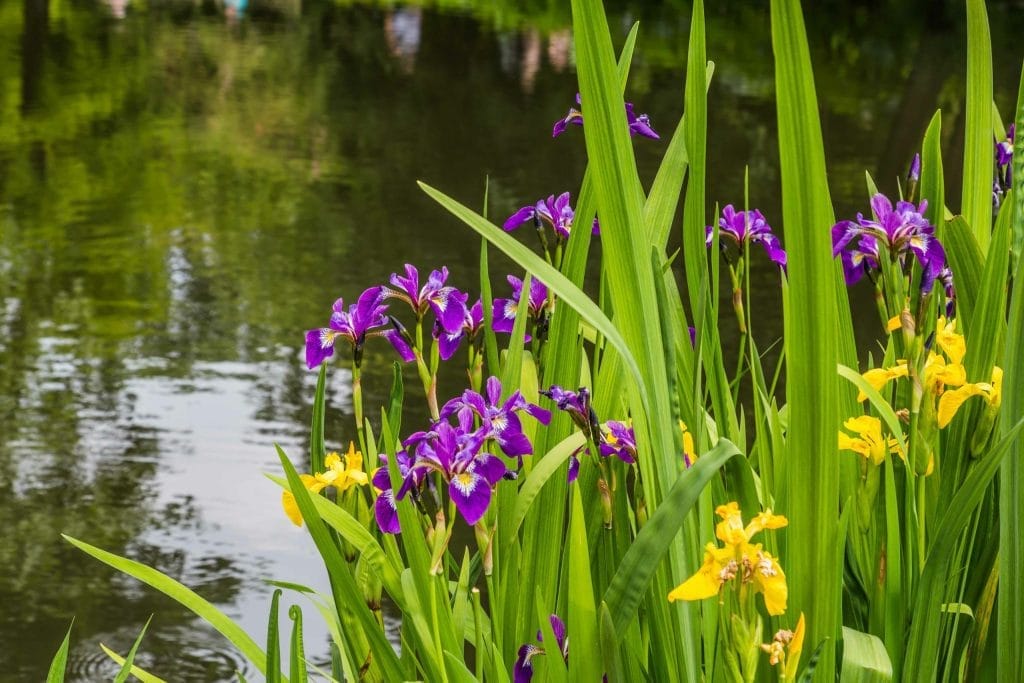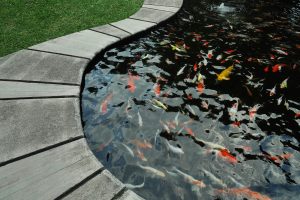
Water Iris Information – Essential Care Tips for Thriving Water Iris Plants
Water irises are beautiful plants that can add colour and life to any pond or water garden.
These aquatic plants thrive in shallow waters and require specific care to flourish.
Knowing how to properly plant and maintain water irises can make all the difference in creating a vibrant aquatic landscape.

There are different varieties of water irises, each with unique characteristics suited to various environments.
Ensuring that they grow in optimal conditions while protecting them from pests and diseases is essential for their health.
Whether a novice gardener or an experienced horticulturist, understanding the nuances of water iris care will enhance any gardening experience.
Key Takeaways
- Water irises require specific planting and growing conditions to thrive.
- Regular maintenance helps protect water irises from common pests and diseases.
- These plants play a vital role in maintaining pond ecosystems and enhancing designs.
Identifying Water Iris Varieties
Water irises are known for their unique beauty and adaptability to wet environments.
This section discusses key characteristics of the Iris genus, outlines common types of water irises, and highlights distinctive traits of true water irises.
Characteristics of Iris Genus
Iris is a diverse genus that includes around 300 species.
These plants are well-known for their striking flowers and sword-like leaves. The foliage can vary in colour, ranging from green to greyish-green.
Most irises thrive in a variety of conditions. Some prefer moist soil, while others flourish in shallow water.
Their root systems help anchor them in wet habitats, ensuring stability.
When identifying water irises, the flower shape and colour are crucial.
The blooms can display a spectrum of shades, including vibrant yellows, blues, and purples. Observing the flower’s structure helps distinguish between the different species within the genus.
Common Types of Water Irises
Several types of water irises are frequently seen in gardens and wetlands. The yellow flag (Iris pseudacorus) is popular for its bright yellow flowers and is often found in marshy areas.
Another noteworthy variety is the blue flag (Iris versicolor), which features striking blue to violet flowers and thrives in wetlands across North America.
Additionally, the Japanese iris (Iris ensata) is known for its large flowers and tolerance of richer soils.
Siberian irises (Iris sibirica) are another common type, recognised for their long lasting blooms and ability to withstand varying light conditions. They typically display various hues like purple and white.
Distinctive Traits of True Water Irises
True water irises are semi-aquatic plants specifically adapted to wet environments.
They require water to cover their crowns throughout the year.
Species such as Iris laevigata and Iris fulva (copper iris) exemplify this category.
Iris laevigata, originating from East Asia, boasts elegant, slender leaves and can grow up to 80 cm tall.
The south blue flag (Iris viginica) expands the range of colours to include blues and purples and prefers shallow waters or marshy areas.
True water irises thrive in environments where their growing conditions mimic their natural habitats.
Optimal Growing Conditions for Water Irises
Water irises thrive best under specific growing conditions.
Factors such as soil type, water depth, and sunlight exposure play crucial roles in their health.
Understanding these needs ensures that water irises can flourish in various environments, from ponds to boggy areas.
Soil Type and Sunlight Exposure
Water irises prefer loamy soil that holds moisture but drains well.
This soil type provides nutrients and supports root growth. They can adapt to wet soil conditions, which are key for their development.
When it comes to sunlight, these plants thrive in full sunlight but can also tolerate some afternoon shade.
Ideally, water irises should receive at least six hours of direct sunlight daily. This exposure promotes robust blooms and healthy foliage, crucial for successful growth.
Water Depth and Quality
Water depth is vital for water irises.
They prefer to have their crowns submerged in shallow water that is typically 0 to 20 cm deep.
The water should ideally cover the base all year to ensure they receive sufficient moisture.
Water quality is also important.
It should be clean and free of contaminants to avoid harming the plants.
Regular maintenance, including the removal of debris, helps keep the growing area healthy. A well-maintained pond or stream promotes optimal conditions for these beautiful plants.
Temperature and Regional Considerations
Water irises are adaptable but thrive best in moderate temperatures.
They are suitable for mild regions, such as those found in Japan, where the climate supports their growth.
During winter, water irises can tolerate cold temperatures, but prolonged frost could harm them.
Therefore, in regions with colder climates, consideration should be given to planting in boggy areas or near the edges of ponds, where they can be protected from harsh conditions.
Planting Water Irises

Planting water irises involves careful preparation and selection to ensure healthy growth.
This section covers site preparation, choosing the right plant varieties, and effective planting techniques to foster optimal conditions for these vibrant pond plants.
Preparation of Planting Site
Before planting water irises, the site needs to be prepared properly.
It is important to choose a location with shallow water or consistently moist soil. Ideal depths range from 15 to 60 cm, depending on the species.
Clear the area of any weeds, debris, or existing plants to prevent competition for nutrients.
If using a pond plant basket or a plastic pot, ensure it has drainage holes. Fill the basket with soil that retains moisture but drains well.
An environment that mimics their natural habitat will support their root system and promote healthier growth.
Selecting Plant Varieties for Your Water Garden
Choosing the right varieties of water iris is crucial for a successful garden.
Some popular species include Iris pseudacorus (yellow flag), Iris laevigata (rabbit-ear iris), and Iris versicolor (blue flag).
Consider the climate, water depth, and sunlight available in the planting area.
For example, some irises prefer full sun, while others can tolerate partial shade.
Select plants suited to local water conditions and ensure that the varieties chosen can coexist if planted together. This will help create a naturally balanced ecosystem in the water garden.
Planting Techniques
When it comes to planting water irises, proper technique ensures successful establishment.
Begin by placing the prepared plants into the pond plant basket or plastic pot.
If using a whiskey barrel, fill it with soil and arrange the plants evenly, ensuring the roots are adequately covered. Position the pot at the correct depth, so the crown of the iris is just below the water’s surface.
Gently backfill any gaps with soil to remove air pockets.
After planting, monitor the water level and keep the area mulched to maintain moisture. Regularly check for any signs of disease or pests to encourage strong growth.
Water Iris Plant Care and Maintenance

Proper care and maintenance of water irises ensure healthy growth and vibrant blooms.
This involves regular feeding, careful pruning, and managing any overgrowth, which plays a significant role in the plant’s longevity and appearance.
Feeding and Fertilisation
Water irises benefit from regular feeding to thrive in aquatic environments.
A good choice is aquatic fertiliser, which provides essential nutrients.
Apply fertiliser during the growing season, typically from spring to early summer.
- Granular Fertiliser: Use slow-release granular fertiliser for continuous feeding.
- Liquid Fertiliser: Apply a diluted liquid form every few weeks for a quick nutrient boost if needed.
Avoid over-fertilising, as it can lead to excess growth and weakened plants.
Regular feeding supports vibrant foliage and healthy blooms.
Pruning and Tidying Foliage
Pruning water irises is essential for maintaining their health and appearance.
Care must be taken to remove yellow or brown leaves.
This not only improves the plant’s look but also promotes better water quality.
In autumn, cut back the foliage to just above the water line, especially in cooler climates. This helps protect the crown of the plant from freezing temperatures.
Additionally, consistently inspect the plants throughout the growing season and trim away any dead or damaged leaves to encourage new growth and vitality.
Managing Overgrowth
Water irises can quickly spread and lead to overcrowding, making management important.
- Repotting: Every year or two, consider repotting them into slightly larger containers to provide them with space to grow.
- Thinning: In late summer, thin out any excess growth by removing some clumps.
By managing their growth, water irises will remain healthy and continue to add beauty to the aquatic environment.
Propagation of Water Irises

Water irises can be propagated effectively through two main methods: division and seed germination.
Each method offers unique advantages and allows for the growth of new plants to enhance garden aesthetics.
Division Method
The division method is one of the most common ways to propagate water irises. This process is typically done in early spring or late summer when the plant is actively growing.
The root system of the iris should be carefully lifted from the water or soil, ensuring minimal damage.
Once removed, the plant can be divided into sections. Each section should contain healthy roots and at least one fan of leaves. The divisions can then be replanted in suitable locations, either in water or moist soil.
It’s essential to ensure that the divided sections are planted at the proper depth, usually just below the water’s surface, to encourage quick re-rooting.
Regular plant care includes monitoring water levels and soil moisture to support the health of new divisions. This method not only helps maintain a healthy colony of water irises but also promotes blooming.
Seed Germination Techniques
Seed germination is another method for propagating water irises, although it requires more time and care. To start, seeds should be collected from mature flowers once they have dried.
Preparing the seeds involves soaking them in water for 24 hours. This helps to soften the seed coat and improves germination rates. After soaking, the seeds can be sown in a seed tray filled with a mixture of potting soil and sand.
It’s crucial to keep the soil consistently moist and place the trays in a bright location but out of direct sunlight to prevent overheating.
Germination typically takes 2-4 weeks. Once seedlings are large enough to handle, they can be transplanted into larger containers or directly into the garden. Good plant care involves regular watering and protection from pests to ensure healthy growth.
Protecting Water Irises from Pests and Disease
Maintaining the health of water irises involves vigilance against pests and diseases. Knowing what to look for and how to prevent these issues is essential for a thriving garden.
Common Pests and Prevention
Water irises can fall victim to various pests. Aphids and beetles are common intruders, often damaging leaves and flowers. Regular inspections are crucial to detect these pests early.
Prevention tactics include:
- Encouraging Natural Predators: Birds and beneficial insects can help control pest populations.
- Using Insecticidal Soap: This is effective against soft-bodied pests like aphids. It’s safe for plants if used as directed.
- Removing Affected Leaves: This helps stop the spread of pests. Damaged foliage should be cut off to maintain plant health.
By regularly checking for these pests, caregivers can keep water irises healthy.
Treatment of Water Iris Diseases
Several diseases can affect water irises, resulting in stunted growth or discolouration. One of the most notable is the Iris Mosaic Virus, which can lead to mottled foliage.
To treat diseases effectively:
- Remove Infected Plants: This prevents disease spread. Disposing of the whole plant is recommended.
- Improve Air Circulation: This can help reduce humidity and deter fungal diseases.
- Use Fungicides: In cases of severe infection, applying appropriate fungicides can help treat the problem. Always follow manufacturer instructions for safety.
Prompt action is critical to minimising the impact of disease on water irises.
Maintaining Water and Soil Quality to Avoid Issues
Quality water and soil are vital to the health of water irises. Contaminated water can introduce harmful toxins that stress the plants.
To ensure a healthy environment:
- Regular Water Changes: This keeps the water clean. Changing the water frequently prevents the build-up of toxins.
- Check Soil pH Levels: Water irises thrive in slightly acidic to neutral soil. Testing the soil can prevent nutrient deficiencies.
- Avoid Over-Fertilisation: Too much fertiliser can lead to toxic conditions in the soil. Balanced fertilisation is important for healthy growth.
By focusing on water and soil quality, caretakers can reduce risks to irises.
Seasonal Water Iris Care
Water irises require specific care throughout the changing seasons to thrive. Each season presents unique tasks that help ensure healthy growth and vibrant blooms. Proper attention during these times will maximise their potential.
Spring Regimen
In spring, water irises begin their growing season. It is essential to check for any winter damage. Trim away any dead or damaged leaves to allow for new growth.
This is also the time to fertilise the plants. Use a balanced aquatic fertiliser to provide nutrients. Apply it according to the manufacturer’s instructions, focusing on the root zone.
If new plants are being added, now is the time to plant them. Ideally, choose a sunny location with moist soil or shallow water. Proper planting promotes healthy root development.
Summer Maintenance
Summer is a critical period for maintaining water irises. They thrive in full sun but can also tolerate partial shade. Ensure they receive at least 6 hours of sunlight daily for optimal growth.
Consistent moisture is crucial during hot months. Regularly check water levels, especially if they are planted near ponds. If necessary, top off any evaporated water to keep the roots submerged.
In addition to watering, monitor for pests and diseases. Quickly remove any affected leaves to prevent spreading. This proactive approach helps maintain plant health and vibrant flowers.
Autumn Preparations
As autumn arrives, water irises need different care. Begin by removing any dead foliage. This helps reduce the risk of disease over the winter months.
Consider trimming back the plants to about 15 cm above the water level. This encourages healthy growth in the spring and helps them survive the colder months.
Additionally, apply a layer of mulch around the base of the plants. This provides insulation against cold temperatures and protects the roots from frost damage.
Winter Survival Strategies
During winter, water irises require minimal maintenance. If they are in shallow water, check to ensure the water remains at a consistent level. Avoid letting the water freeze solid, as this can damage the plants.
For those in colder climates, consider placing a floating device on the water surface. This helps prevent complete freezing and provides air for the plants beneath the ice.
It is also beneficial to leave the foliage intact during winter. This natural covering protects the crown and roots from harsh winter conditions. When spring arrives, the old leaves can be pruned back, making way for new growth.
Landscaping with Water Irises
Water irises are excellent additions to gardens with ponds, streams, or wet areas. They enhance the beauty of these spaces while providing various benefits, including attracting wildlife.
This section discusses how to design around pond features, combine water irises with other aquatic plants, and create stunning focal points.
Designing Around Pond Features
When designing a landscape around a pond, water irises can create a natural-looking edge. Placing them along the water’s edge helps blend the garden with the pond, softening the transition from land to water.
Choosing varied heights adds depth; taller water irises can stand at the back while shorter ones can frame the front. Consider using groups of three or five to create a more organic appearance.
The colours of the irises, such as the bright yellows and blues, can reflect and complement the water, making the overall design more cohesive.
Combining With Other Aquatic Plants
Water irises thrive when planted with other aquatic plants. By combining them with species like water lilies or cattails, a gardener can create a rich, biodiverse habitat. This pairing not only enhances the aesthetics but also promotes ecological balance.
For example, water lilies can provide shade, which can benefit the water irises during hot weather. Additionally, taller species like rushes can act as a backdrop, highlighting the beauty of the irises.
Care should be taken to ensure that all plants have similar moisture requirements to thrive together.
Creating Focal Points with Water Irises
Water irises can act as striking focal points in a garden landscape. Their vibrant flowers attract attention, making them ideal for placement near pathways or sitting areas. To create a stunning visual impact, they can be planted in groups or clusters.
An effective method is using contrasting colours. For example, pairing the blue flag iris with the yellow flag iris creates a vivid display.
Additionally, planting irises in containers can allow for mobility, providing options to rearrange them as needed. These strategies can enhance the overall beauty of the garden while ensuring that water irises remain a highlight.
Water Iris in Ecosystems and Water Treatment
Water irises play a significant role in their environments and are valuable in water treatment processes. They contribute to habitat diversity and enhance water quality by filtering toxins.
Role in Natural Habitats
Water irises, such as the Iris pseudacorus (yellow flag) and Iris fulva (red flag or copper iris), thrive in wetlands, ponds, and riverbanks. These plants create crucial habitats for various wildlife, including insects, birds, and amphibians.
Their dense foliage provides shelter and breeding grounds, supporting biodiversity.
Moreover, they stabilize banks, preventing erosion and providing food and resources for aquatic life. The roots of water irises also improve soil health by encouraging beneficial microorganisms to thrive.
Contributions to Water Filtration
Water irises are effective in improving water quality through their natural filtration abilities. They absorb nutrients like nitrogen and phosphorus, which can cause algae blooms and harm aquatic ecosystems.
By taking up these nutrients, water irises help maintain a balanced environment. They also trap toxins and pollutants in their root systems, reducing contamination levels in aquatic spaces.
This capability makes them valuable in constructed wetlands and stormwater management systems. Using water irises can support cleaner water and healthier ecosystems, making them an excellent choice for environmental management.
Troubleshooting Common Issues with Water Irises
Water irises may face several challenges that affect their growth and blooming. It is important to identify the specific issues to implement effective solutions. Common problems include stunted growth, poor blooming, and unsatisfactory water conditions.
Addressing Stunted Growth
Stunted growth in water irises can stem from inadequate sunlight or poor water quality. These plants thrive best in bright conditions and should receive at least six hours of sunlight daily. If they are in too much shade, consider trimming surrounding plants that block light.
Water quality also plays a crucial role. Water that is too murky or has high levels of nutrients can hinder growth. It is essential to maintain clean water, changing a portion regularly to ensure it stays fresh. Regularly removing any dead leaves or debris can also promote healthy growth.
Solving Flowering Problems
When water irises fail to bloom, it often relates to insufficient watering or a lack of nutrients. These plants need consistently moist soil but should never sit in soggy conditions. Ensuring proper watering will help facilitate blooming.
Another factor is nutrient supply. They may require fertilising during the growing season. A balanced fertiliser, applied every few weeks, can provide essential nutrients to encourage the formation of flowers. Monitoring and adjusting these conditions can enhance blooming success.
Correcting Poor Water Conditions
Water conditions directly impact the health of water irises.
Ideal conditions include clear, clean water that is not overly stagnant. Stagnant water can lead to algae growth, which can smother the plants.
Aeration can be beneficial, so consider using a fountain or aerator to improve water flow.
Additionally, avoiding chemical treatments is important, as harsh chemicals can negatively affect both the plants and water quality.
Regularly testing water for pH and nutrient levels can help ensure optimal health for the irises.
Conservation of Water Iris Species
Water iris species face various threats, including habitat loss and climate change.
Understanding Threats to Native Species
Many water iris species, such as the yellow flag iris (Iris pseudacorus) and blue flag iris, are under threat due to urban development and pollution.
Habitat degradation from agricultural activities also has adverse effects.
Invasive species can compete with native irises, leading to a decline in their populations.
For instance, red flag iris suffers from invasive plant species that consume the resources it needs to thrive.
Climate change further complicates the situation by altering water levels and temperatures, making it difficult for these plants to survive in their natural habitats.
Cultivation and Preservation Efforts
Conservation efforts focus on both in-situ and ex-situ strategies.
In-situ conservation involves protecting natural habitats while promoting healthy ecosystems for water-loving species like the southern blue flag.
Restoration projects often aim to reduce pollution and control invasive species, creating a more suitable environment for irises.
Ex-situ conservation includes cultivating these species in botanical gardens or nurseries, ensuring they are preserved away from their native habitats.
Public awareness and education about the importance of these plants aid conservation efforts, encouraging garden enthusiasts to plant and care for bearded iris and other native varieties in their own gardens.



